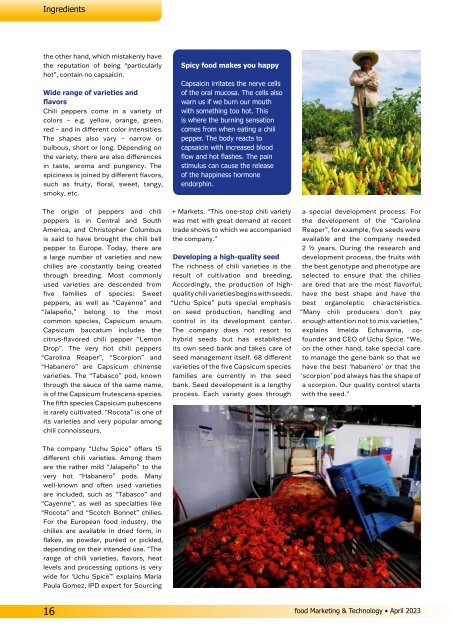food Marketing - Technology 2/2023
food Marketing & Technology is the international magazine for executives and specialists in the food industry.
food Marketing & Technology is the international magazine for executives and specialists in the food industry.
You also want an ePaper? Increase the reach of your titles
YUMPU automatically turns print PDFs into web optimized ePapers that Google loves.
Ingredients<br />
the other hand, which mistakenly have<br />
the reputation of being “particularly<br />
hot”, contain no capsaicin.<br />
Wide range of varieties and<br />
flavors<br />
Chili peppers come in a variety of<br />
colors – e.g. yellow, orange, green,<br />
red – and in different color intensities.<br />
The shapes also vary – narrow or<br />
bulbous, short or long. Depending on<br />
the variety, there are also differences<br />
in taste, aroma and pungency. The<br />
spiciness is joined by different flavors,<br />
such as fruity, floral, sweet, tangy,<br />
smoky, etc.<br />
Spicy <strong>food</strong> makes you happy<br />
Capsaicin irritates the nerve cells<br />
of the oral mucosa. The cells also<br />
warn us if we burn our mouth<br />
with something too hot. This<br />
is where the burning sensation<br />
comes from when eating a chili<br />
pepper. The body reacts to<br />
capsaicin with increased blood<br />
flow and hot flashes. The pain<br />
stimulus can cause the release<br />
of the happiness hormone<br />
endorphin.<br />
The origin of peppers and chili<br />
peppers is in Central and South<br />
America, and Christopher Columbus<br />
is said to have brought the chili bell<br />
pepper to Europe. Today, there are<br />
a large number of varieties and new<br />
chilies are constantly being created<br />
through breeding. Most commonly<br />
used varieties are descended from<br />
five families of species: Sweet<br />
peppers, as well as “Cayenne” and<br />
“Jalapeño,” belong to the most<br />
common species, Capsicum anuum.<br />
Capsicum baccatum includes the<br />
citrus-flavored chili pepper “Lemon<br />
Drop”. The very hot chili peppers<br />
“Carolina Reaper”, “Scorpion” and<br />
“Habanero” are Capsicum chinense<br />
varieties. The “Tabasco” pod, known<br />
through the sauce of the same name,<br />
is of the Capsicum frutescens species.<br />
The fifth species Capsicum pubescens<br />
is rarely cultivated. “Rocota” is one of<br />
its varieties and very popular among<br />
chili connoisseurs.<br />
+ Markets. “This one-stop chili variety<br />
was met with great demand at recent<br />
trade shows to which we accompanied<br />
the company.”<br />
Developing a high-quality seed<br />
The richness of chili varieties is the<br />
result of cultivation and breeding.<br />
Accordingly, the production of highquality<br />
chili varieties begins with seeds.<br />
“Uchu Spice” puts special emphasis<br />
on seed production, handling and<br />
control in its development center.<br />
The company does not resort to<br />
hybrid seeds but has established<br />
its own seed bank and takes care of<br />
seed management itself. 68 different<br />
varieties of the five Capsicum species<br />
families are currently in the seed<br />
bank. Seed development is a lengthy<br />
process. Each variety goes through<br />
a special development process. For<br />
the development of the “Carolina<br />
Reaper”, for example, five seeds were<br />
available and the company needed<br />
2 ½ years. During the research and<br />
development process, the fruits with<br />
the best genotype and phenotype are<br />
selected to ensure that the chilies<br />
are bred that are the most flavorful,<br />
have the best shape and have the<br />
best organoleptic characteristics.<br />
“Many chili producers don’t pay<br />
enough attention not to mix varieties,”<br />
explains Imelda Echavarria, cofounder<br />
and CEO of Uchu Spice. “We,<br />
on the other hand, take special care<br />
to manage the gene bank so that we<br />
have the best ‘habanero’ or that the<br />
‘scorpion’ pod always has the shape of<br />
a scorpion. Our quality control starts<br />
with the seed.”<br />
The company “Uchu Spice” offers 15<br />
different chili varieties. Among them<br />
are the rather mild “Jalapeño” to the<br />
very hot “Habanero” pods. Many<br />
well-known and often used varieties<br />
are included, such as “Tabasco” and<br />
“Cayenne”, as well as specialties like<br />
“Rocota” and “Scotch Bonnet” chilies.<br />
For the European <strong>food</strong> industry, the<br />
chilies are available in dried form, in<br />
flakes, as powder, puréed or pickled,<br />
depending on their intended use. “The<br />
range of chili varieties, flavors, heat<br />
levels and processing options is very<br />
wide for ‘Uchu Spice’” explains Maria<br />
Paula Gomez, IPD expert for Sourcing<br />
16 <strong>food</strong> <strong>Marketing</strong> & <strong>Technology</strong> • April <strong>2023</strong>

















